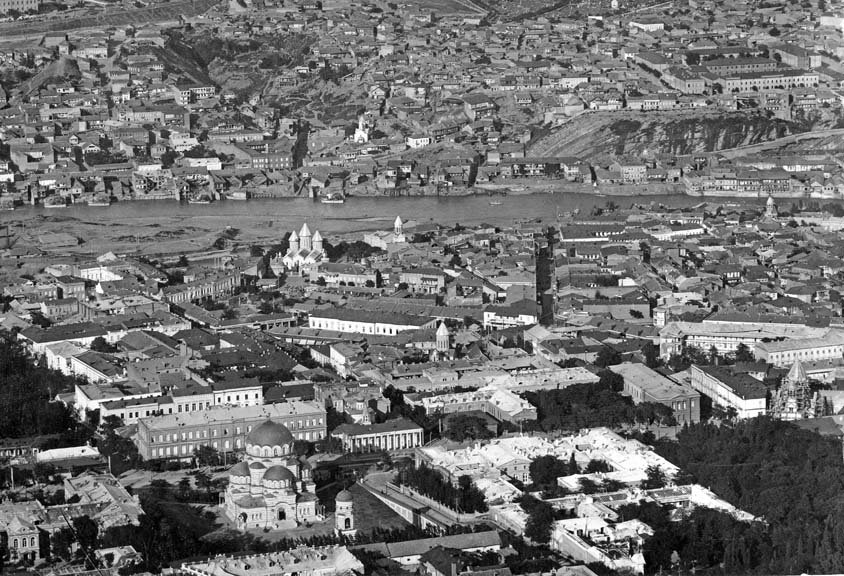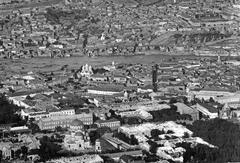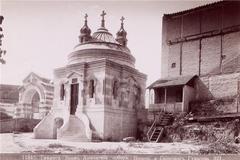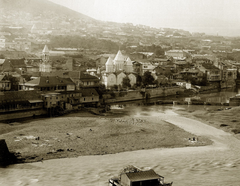
Armenian Cathedral of Tbilisi: Visiting Hours, Tickets, and Historical Significance
Date: 14/06/2025
Introduction
Nestled in the heart of Tbilisi’s Old Town, the Armenian Cathedral of Tbilisi—officially the Cathedral of Saint George (Surb Gevorg)—is one of the city’s most important religious and cultural landmarks. Renowned for its deep historical roots, striking Armenian ecclesiastical architecture, and vibrant role within Tbilisi’s multicultural tapestry, the cathedral offers visitors a unique opportunity to explore centuries of Armenian heritage in Georgia. Whether you are a history enthusiast, architecture lover, or a traveler eager to experience Tbilisi’s diverse spiritual landscape, the Armenian Cathedral is a must-see destination (SpottingHistory; ivertubani.com; wander-lush.org).
Table of Contents
- Origins and Early Development
- Foreign Rule, Restoration, and Architectural Evolution
- Cultural and Religious Importance
- Soviet Era and Modern Revival
- Visiting the Armenian Cathedral of Tbilisi
- Frequently Asked Questions (FAQ)
- Conclusion
- Sources and Further Reading
Origins and Early Development
The origins of the Armenian Cathedral of Tbilisi trace back to 1251, when it was founded under the patronage of Armenian merchant Umek Karian. This foundation is supported by historical chronicles and an Arabic-inscribed khachkar above the west door (SpottingHistory; Kamit.jp). During the Middle Ages, Armenians comprised a significant segment of Tbilisi’s population. The cathedral quickly became a central spiritual and cultural hub for the Armenian community, which at its peak maintained over two dozen churches and monasteries in the city (Wikipedia: Armenians in Tbilisi).
Foreign Rule, Restoration, and Architectural Evolution
The cathedral’s history is marked by periods of foreign domination, destruction, and renewal. In 1616, Safavid Persian ruler Shah Abbas I seized the church, converting it for military use before it was restored to the Armenian community in 1748 by King Heraclius II of Georgia (SpottingHistory). The Persian sack of Tbilisi in 1795 caused significant damage, leading to multiple restorations, notably in the 17th century, 1832, and 1881 (Kamit.jp).
Architecturally, the cathedral features the classic Armenian cruciform plan, a prominent dome with a Georgian-influenced decorative drum, brick construction, and stucco-covered outer walls. The interior is adorned with murals and frescoes by notable Armenian artists such as Hovnatan Hovnatanian and Gevorg Bashinjaghian, spanning centuries and reflecting both Armenian and Georgian artistic traditions (Kamit.jp; ibnbattutatravel.com).
Cultural and Religious Importance
Beyond its role as a place of worship, the Armenian Cathedral of Tbilisi has long served as a center for cultural enlightenment and identity preservation within the Armenian diaspora in Georgia. The surrounding courtyard is the final resting place for luminaries such as Sayat-Nova and Gevorg Bashinjaghian. The richly decorated interior—with frescoes dating from the 14th to the 20th centuries—offers a window into the evolution of Armenian ecclesiastical art within a Georgian context (IDEA.am; SpottingHistory).
The cathedral’s symbolic position in Tbilisi’s multicultural Old Town, surrounded by synagogues, mosques, and churches, makes it a living testament to the city’s religious pluralism and history of coexistence (wander-lush.org).
Soviet Era and Modern Revival
During the Soviet era, many Armenian churches in Tbilisi were confiscated or repurposed, and religious expression was severely restricted. After the demolition of the Vank Cathedral in the 1930s, St. George’s Cathedral became the seat of the Armenian Apostolic Church in Georgia, remaining a focal point of faith and resilience for the community (SpottingHistory; Wikipedia: Armenians in Tbilisi).
Comprehensive restoration efforts after Georgian independence culminated in 2015, revitalizing the cathedral’s murals, iconostasis, and structural elements. The discovery of previously hidden frescoes has further enhanced its status as an artistic and spiritual treasure (IDEA.am). Notably, in October 2022, the cathedral hosted the reburial of relics from the former Vank Monastery, deepening its ongoing cultural and religious significance (Armenian Church Georgia).
Visiting the Armenian Cathedral of Tbilisi
Visiting Hours and Tickets
- Opening Hours: The cathedral is generally open daily from 9:00 AM to 6:00 or 7:00 PM. Hours may vary on major religious holidays; checking ahead is advisable (Next Level of Travel).
- Entry: Entrance is free. Donations are appreciated to support maintenance and ongoing restoration (ibnbattutatravel.com).
Accessibility
The cathedral is located at 3 Samghebro Street in Old Tbilisi, easily reachable on foot from major city landmarks. While the entrance is at street level, the surrounding cobblestone streets and the lack of dedicated ramps may present challenges to visitors with limited mobility. Assistance can be arranged upon request.
Guided Tours
Guided tours—both in-person and via audio guides such as the Audiala app—are available and highly recommended for a deeper understanding of the cathedral’s history, art, and role in Tbilisi’s multicultural community. Booking guided tours in advance, especially during peak tourist seasons, is advised (Tourist Secrets).
Nearby Attractions
The cathedral’s central location makes it an ideal starting point for exploring Tbilisi’s Old Town. Notable nearby sites include:
- Narikala Fortress: Overlooking the city and offering panoramic views.
- Metekhi Church: Historic Georgian Orthodox site with scenic surroundings.
- Great Synagogue of Tbilisi: Reflects the city’s Jewish heritage.
- Anchiskhati Basilica: The oldest church in Tbilisi.
- Sulfur Baths (Abanotubani): Traditional bathhouses for a unique cultural experience (Next Level of Travel; Tourist Secrets).
Photography and Visitor Etiquette
Photography is permitted, though visitors are asked to avoid flash to protect delicate frescoes and to refrain from photographing during religious services without permission. Modest dress is expected (shoulders and knees covered), and women are encouraged to wear headscarves, especially during services. Maintaining a respectful silence and decorum inside the cathedral is essential (Reddit Travel Report).
Frequently Asked Questions (FAQ)
Q: What are the cathedral’s visiting hours?
A: Generally, 9:00 AM to 6:00/7:00 PM daily, with possible variations on religious holidays.
Q: Is there an entrance fee?
A: No, entry is free; donations are appreciated.
Q: Are guided tours available?
A: Yes, guided tours and audio guides are available both onsite and through the Audiala app.
Q: Is the cathedral accessible for people with disabilities?
A: The entrance is at street level but lacks ramps; cobblestones may hinder wheelchair access.
Q: Is photography allowed?
A: Photography is generally permitted except during services. Flash should not be used.
Conclusion
The Armenian Cathedral of Tbilisi is a living monument to the enduring Armenian presence and the city’s broader multicultural past. Its rich architectural features, centuries-old frescoes, and vibrant community life make it one of Tbilisi’s most rewarding destinations for cultural discovery. With free entry, centrally located in the atmospheric Old Town, and surrounded by historical landmarks, the cathedral is both accessible and essential for visitors seeking to understand Tbilisi’s diverse heritage.
For the fullest experience, consider joining a guided tour or using the Audiala app for in-depth historical and artistic insights. Remember to dress respectfully and check for any special events before your visit.
Sources and Further Reading
- Armenian Cathedral of Tbilisi: History, Visiting Hours, and Travel Tips for Exploring a Tbilisi Historical Site, 2025, SpottingHistory (https://www.spottinghistory.com/view/8962/saint-georges-church/)
- St. George Cathedral Tbilisi: A Historic Armenian Landmark and Visitor’s Guide, 2025, ivertubani.com (https://ivertubani.com/local-experiences/exploring-tbilisis-diverse-religious-sites/)
- Visiting the Armenian Cathedral of Tbilisi: Hours, Tickets & Architectural Highlights, 2025, ibnbattutatravel.com (https://en.ibnbattutatravel.com/place/st-george-cathedral-of-tbilisi/)
- Visiting the Armenian Cathedral of Tbilisi: Hours, Tickets, and Historical Insights, 2025, Next Level of Travel (https://www.nextleveloftravel.com/georgia/tbilisi-itinerary-for-2-days/)
- Armenian Cathedral of Tbilisi, Kamit.jp (http://www.kamit.jp/18_armenia/07_neighbor/nei_eng.htm)
- IDEA.am – Surb Gevorg Cathedral Project, 2025 (https://www.idea.am/project/surb-gevorg-cathedral/)
- Wander Lush – Best Churches in Tbilisi, 2025 (https://wander-lush.org/best-churches-in-tbilisi-georgia/)
- Tourist Secrets – Two Weeks in the Caucasus Travel Itinerary, 2025 (https://www.touristsecrets.com/travel-guide/adventure/two-weeks-in-the-caucasus-travel-itinerary-for-georgia-armenia-and-azerbaijan/)
- Reddit Travel Report – 4 Days in Tbilisi, 2025 (https://www.reddit.com/r/TravelNoPics/comments/vgjx4t/4_days_in_tbilisi_georgia_first_solo_trip_report/)


































